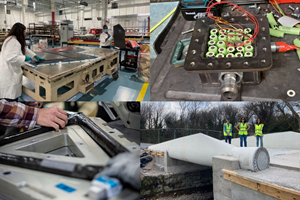When design and engineering meet
In a designer’s perfect world, the challenge of manufacturability does not exist.
In a designer’s perfect world, the challenge of manufacturability does not exist. Neither does cycle loading, fatigue, bird strike, mass, cycle time or warpage. In this perfect world, any fiber in any form can be combined with any resin in any tool in any process to produce a part of unlimited shape, contour and application. All materials are immune to sun, wind, rain, gravity, baseball bats and other forces of the physical world. In a designer’s perfect world, the only hurdle is imagination.
In an engineer’s perfect world, there are no aesthetics, color palettes, unnecessary curves, unwanted angles, wasted space or design iterations. Here, utility, application, strength, performance, durability, longevity and integrity are paramount. And only certain fibers go with certain resins in certain tools for certain processes. Thermodynamics, fluid dynamics, force dynamics and cycle loading mean a great deal where the engineer lives. And what matters most is resistance to sun, wind, rain, gravity, baseball bats and all the other forces of the physical world.
Sadly, of course, we live in the real world. What’s more, both the designer and engineer are forced to coexist, cooperate and occasionally clash in what the rest of us call reality. The symbiotic relationship between designers and engineers, particularly those who collaborate on composites parts, is not a new one. For years it’s been the designer’s job to conceive of designs that appeal to our sense of touch, feel and sight, all within the realm of manufacturability and feasibility. It’s been the engineer’s job to take that design, specify materials and then cut them, lay them up and mold them into a shape that meets the customer’s needs. In between is all of the back and forth between designer and engineer as designs and specifications change.
Managing that change and understanding what it means to the final product is a discipline in itself. One rapidly evolving tool, finite element analysis (FEA), is playing a bigger role in the design and manufacture of composites parts, allowing everyone up and down the product development chain to understand quickly what the implications are for design and material changes. FEA has, traditionally, been an engineering tool, but as our report this issue on p. 32 shows, analysis is migrating toward the designer. Several FEA packages are now bundled with well-known CAD packages, and designers overall are being tasked with using FEA to prove and adjust designs to meet processing and performance goals. This means that the designer and the engineer in many shops, though they still clash at times, are seeing their collaborative efforts produce better products.
In a similar vein, on p. 28, you’ll find a report on the development of composite crush structure data for use in the automotive industry. While the aerospace industry has had its own data for some time on composites’ energy-absorbing characteristics in aircraft, the automotive engineer can’t just look over the aerospace engineer’s shoulder, as it were. The aerospace engineer and automotive engineer assess crashworthiness from significantly different perspectives. An airplane’s structure is typically evaluated for crashworthiness at what for an automobile would be extremely high speeds, while a car’s ability to absorb crash impact matters most at comparatively low speeds in mostly “survivable” situations. The emerging data on automotive composite structures certainly will be a helpful guide for designers trying to meet the emerging needs of the automotive industry – and bring designers and engineers that much closer together.
Related Content
As 2023 begins, a look back at trending CW topics in 2022
With 2022 now behind us, CW’s editor-in-chief Jeff Sloan takes a look at the CW stories last year that received the most reader attention.
Read MoreWhy aren't composites synonymous with infrastructure?
The U.S. seems poised to invest heavily in infrastructure. Can the composites industry rise to the occasion?
Read MoreRemembering Don Adams
When one thinks of composites test methods, one thinks of Don Adams. Don passed away at the end of 2022. We remember him here.
Read MoreSustainability has come to composites and it's here to stay
It might be tempting to think of sustainability as a buzzword, but there are structural changes taking place in the composites industry that signal its permanence.
Read MoreRead Next
Composites end markets: Energy (2024)
Composites are used widely in oil/gas, wind and other renewable energy applications. Despite market challenges, growth potential and innovation for composites continue.
Read MoreFrom the CW Archives: The tale of the thermoplastic cryotank
In 2006, guest columnist Bob Hartunian related the story of his efforts two decades prior, while at McDonnell Douglas, to develop a thermoplastic composite crytank for hydrogen storage. He learned a lot of lessons.
Read MoreCW’s 2024 Top Shops survey offers new approach to benchmarking
Respondents that complete the survey by April 30, 2024, have the chance to be recognized as an honoree.
Read More


























